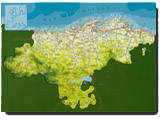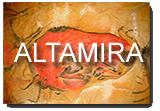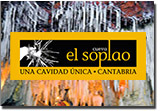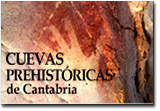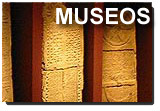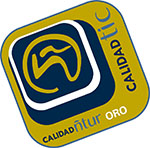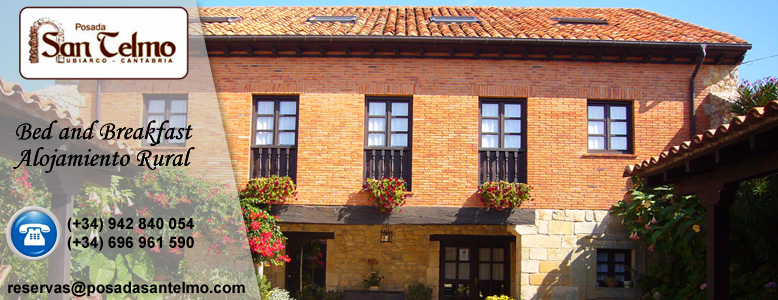
Information  Regional Gastronomy Regional Gastronomy
|
Cantabria, thanks to its privileged geographical location, in the center of the Cantabrian coast, is influenced by a truly exceptional natural environment, where landscapes and ecosystems take turns to host the most select variety of gastronomic raw materials: the Cantabrian sea, with its fine fish and delicate seafood; swift-running fast-flowing rivers whose high basins treasure the king of the river, salmon, and the delitious "terciada" trout; kitchen gardens tiny in area yet huge in the quality of their vegetables; a land covered by evergreen meadows plenty of grass that feeds a strong bovine cattle stock of the highest quality; narrow valleys with warm and gentle microclimates that help produce exquisit fruit.
In short, a wide variety of gastronomic alternatives that will turn Cantabrian cuisine into a faithful companion through all your trips around the geography of our region.
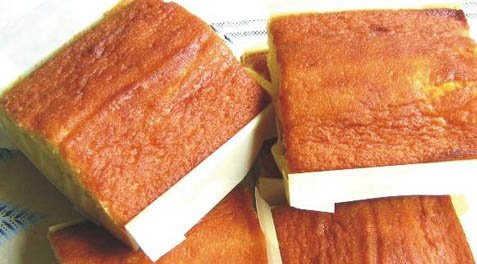
Sobaos Pasiegos, dulce t�pico de Cantabria

As a sample of that gastronomic variety, we offer you some of its most famous recipes, so that you can practice at home and surprise your guests. Enjoy your meal!
Lettuce and Tomato Salad
Buy a green medium-sized lettuce heart; wash the leaves, dry them well (very important) and cut them. Slice or dice some medium-sized tomatos. Add salt, olive oil and vinegar. Toss well and serve
Fish Soup
Ingredients (4 people): 500 gm. of angler fish, 1 scorpion fish, 200 gm. of clams, onion, 2 ripe tomatos, 2 leeks, 1clove of garlic, 1 hard-boiled egg, 1 bay leaf, 1 chili, one glass of dry white wine, olive oil and salt.
Cook the fish in a pan for 30 min. with water and salt, the bay leaf, sliced onion and a good drop of white wine. After cooking, separate the fish from its juice, remove its skin and bones and set it aside.
Stray the juice and put it back in the pan. In another pan, add a thinly sliced onion and the chopped garlic, the leeks and the peeled and sliced tomatos, and toss in oil over a gentle heat for 15 minutes; then, pass through the conical strainer.
In another pan, mix the tossed ingredients, the juice and what remains of the white wine. Cook for 20 min. Add the clams and the pieces of fish. Control the level of salt. Cook until the clams open. Add the hard-boiled egg, and this splendid soup is ready to be offered to your guests.
Clams "A la Marinera" (Sailor-fashioned): typical Santander dish
Ingredients: 1 kg. of clams, 3 cloves of garlic, 1 chili, parsley, half an onion, breadcrumbs, half a glass of white wine, the juice of half a lemon, olive oil and salt.
Wash well the clams (it is advisable to leave them to soak some hours before, in abundant water and with a fistful of salt) and cook them with half a glass of water in a frying pan, over a high heat. Take them to a bigger casseruole when they open, and then strain the broth and set it aside.
Use the oil to fry the sliced onion and garlic until golden brown in a frying pan. Then add a big spoonful of breadcrumbs and cook for some more time, adding the broth, the white wine, the lemon juice and the chili. Pour over the clams, leaving them to cook over a very gentle heat from 5 to 10 min. Give the last touch by adding the salt and the chopped parsley.
Tuna "Marmita" (Pot): typical dish of the Cantabrian coast
Ingredients: 500 gm. of fresh tuna, 750 gm. of potatos, 2 onions, 4 ripe tomatos, 2 green peppers, 2 red peppers, 2 cloves of garlic, 1 bay leaf, pepper, hot paprika, half a glass of white wine, olive oil and salt.
Chop the onions and peppers in little pieces. Peel the tomatos and potatos and cut them in uneven pices. In a casseruole, with a bit of hot oil, toss the onions. When they start turning brown, add the peppers and then the tomatos. Cover and leave to cook very slowly. Smash the garlic in a mortar, then add the white wine and pour the mix in the casseruole.
Add the bay leaf, salt, pepper and paprika and leave to cook for some 5 min. more. Add the potatos. Toss them for a while so that they absorb some of the flavour of the other ingredients and then add water enough to cover them. Leave to cook over a gentle fire. When the potatos are ready, add the tuna, cut in big dices, and leave to cook for another 10 min. Check the salt, leave to rest for 5 min., and then it�s ready.
Elvers "A la Cazuela" (Casserole-cooked) : typical dish from the As�n and Soba Valleys
Ingredients (4 people): 400 gm. of elvers, 4 clovers of garlic, 4 chili rings, 1.5 dl. of olive oil and salt.
Pour and heat the oil in a casseruole. When it is hot, add the sliced garlic and the chili rings, and when the garlic starts turning brown, set aside from the fire and let it cool. Then, add the previously cooked elvers and put the casseruole back on the fire, stir with a wooden fork, always over a high heat, and add salt. Before they boil, set aside from the fire and serve quickly in small individual casseruoles
Baby Squids with Onion
Ingredients: 1 Kg. of baby squids (little), 2 onions, half a glass of white wine, olive oil and salt.
Pour three spoonfuls of olive oil in a frying pan, slice the onions thinly, add the clean baby squids and add salt.
When in the middle of the cooking, add the half glass of white wine and stir constantly with a wooden fork.
Keep on a medium heat for half an hour until the water from the onion boils away. Cover and leave to rest for 5 min., and it�s ready.
Barnacles
Cook in a pan with water enough to cover the barnacles, and with 80 gm. of salt per litre of water (this is a key point). When the water starts to boil, add the barnacles and don�t set aside from the fire until it boils again. Put the barnacles in a serving dish, covering them quickly with a cloth to keep the heat, and they are ready to consume.
Quality barnacles are those with a short, thick and tight body.
Scorpion Fish Pudding
Ingredients (4 people): 1 scorpion fish of around 1 kg. of weight, 1 lettuce, 1 onion, 1 carrot, parsley, 1 bay leaf, pepper, 1 small glass of white wine, 1 dl. of tomato sauce, 4 eggs, 1 can of evaporated milk, and salt.
In a pot filled with water, cook for about 10 min. the onion, the carrot, the bay, the parsley, the white wine and the salt. Then add the fish and leave to cook for 15 min. Remove skin and bones from the fish, chop carefully and set aside.
In a bowl, whisk the eggs, and then add the tomato sauce, the evaporated milk, the salt, and the pieces of fish. Whisk until everything turns into a thin paste.
Oil a baking mould, place more oiled paper on the bottom, and then pour everything in. Warm the oven up into medium temperature, and then put the mould in bain-marie inside. Leave to cook for some 40 or 45 min. Check if it�s cooked by pricking with a needle. Don�t separate from the mould until cold. To serve with mayonnaise and decorated with the leaves of the lettuce.
Snails with Nuts and Cured Pork Dewlap Meat
Ingredients: hard-shell snails, onions, garlic, "choricero" peppers, cured pork dewlap meat, nuts, salt, olive oil and chili.
Clean the snails thoroughly with salty water or vinegar, and then put them in a pot with cold water. When they begin to boil, set aside and change the water. This second time add some salt and a whole onion, a couple of peppers, one or two chilis, and leave to cook for 30 min.
In order to prepare the sauce, we toss the onion and the garlic in oil in a pan, and then add the dewlap meat, diced in little pieces. To help mix everything, pour a bit of flour, and then add the chopped nuts and the "choricero" peppers, that have been previously soaked in hot water and put through a food mill.
Mix everything in a casseruole, add a bit of water and leave to cook for a while for the final touch.
Mountain Stew
Ingredients (4 people): 100 gm. of white beans, 100 gm. of chorizo (typical spanish hard pork sausage) and blood sausages, 1 pork knee bone, 250 gm. of pickled pork chops, 200 gm. of fresh or pickled salt pork, 1 piece of pork ear, 1 cabbage, 1 turnip, 2 medium-sized potatos and 500 gm. of pickled pork meat
In a big pot filled with cold water, cook the beans with the knee bone, the pork ear, the chorizo, the pork chops, the meat and the salt pork (after having washed everything before), for an hour, more or less. Wash and clean the cabbage, the potatos and the turnip, peeled, scraped and cut in little pieces. When the meat we�ve been cooking is tender, add the cabbage, the potatos and the turnip, letting everything cook over a gentle fire, so that the cabbage gets the flavour from all the other ingredients.
Wash and clean the cabbage, the potatos and the turnip, peeled, scraped and cut in little pieces. When the meat we�ve been cooking is tender, add the cabbage, the potatos and the turnip, letting everything cook over a gentle fire, so that the cabbage gets the flavour from all the other ingredients.
When everything is cooked, add salt and the blood sausages (after having washed them well), pricking them with a fork so that they don�t burst, and cook everything together for some 10 or 15 min. Then set the pork ingredients aside and cut them in pieces, so that each person can choose if they want them mixed with the stew or as a separate dish.
It is doubly exquisite if it is left to rest from one day to the other.
Li�bana Valley Stew: typical dish from the Li�bana Valley.
Ingredients: 500 gm. of beef shank, 250 gm. of cecina (smoked meat), 100 gm. of chorizo (typical spanish hard pork sausage), 200 gm. of salt pork, 2 pork knee bones, 200 gm. of cured ham, 1 cabbage, 4 potatos, 250 gm. of Li�bana Valley chickpeas, garlic, 2 eggs, breadcrumbs, parsley, pepper, milk, noodles, olive oil and salt.
Leave the chickpeas to soak the day before, for around 12 hours. In a deep pot full of cold water, put the meat, the cecina, the chorizo, the salt pork, the eggs and the ham. Put to cook, and when it boils, add the chickpeas and leave to cook slowly until everything is tender. Before ending the cooking, add the diced potatos and cabbage, and the salt. Strain the broth and prepare a soup with the noodles. In order to prepare the stuffing, in another bowl, whisk the eggs, add the chopped garlic and parsley and some of the meat in really small pieces. Add some breadcrumbs soaked in milk and well strained. Knead everything together in the shape of rolls, and fry in really hot oil until golden brown.
Then, boil the stuffing in some of the broth of the stew for 15 min. Serve the soup as starter and then, as the main course, the meat with the vegetables and the stuffing.
Railway Stew: typical dish from the area of Campoo and Valderredible.
The origins of this dish are in the practices of the railway workers of the old La Robla railway; they used to prepare it by using the steam of the machinery of the trains. Nowadays, you use a container big enough to put inside the coal, and on top, fitting with the container, a pot where the stew is prepared. It has lean meat, garlic and onion. All these ingredients must be browned well, and when the meat has produced juice enough, add diced leek, green pepper, carrot and bay leaves, and white wine too. Stir well and add the diced potatos and water enough to cover them, and end the cooking over a gentle fire.
Stewed Red Kidney Beans: typical dish from the Saja-Nansa area.
Ingredients (4 people): 250 gm. of red kidney beans, 1 onion, 2 cloves of garlic, 1 bay leaf, paprika, 20 gm. of flour, olive oil and salt.
First of all, leave the kidney beans to soak in cold water during the night.
Wash the beans and put them in a pot with cold water, add the sliced onion, the peeled cloves of garlic, the bay leaf and a good jet of oil. Put over the fire, and when it starts to boil, cut the boiling with a jet of cold water. Leave it to cook again, but keeping it over a gentle fire, checking that the beans are always covered in water, adding when necessary. When they are tender and ready, set them aside. In a frying pan, brown the flour and the paprika together, add a bit of the broth of the previous cooking, and pour the mix on the beans. Add salt and leave to cook for some minutes. Let it rest a while, remove the bay leaf and the onion, and it is ready.
Sirloin Steak with Tresviso Cheese Sauce
Ingredients (4 people): 1 kg. of bovine sirloin, 150 gm. of Tresviso cheese, 1 onion, parsley, pepper, 5 dl. of milk, a jet of cognac, olive oil and salt.
Cut the sirloin pieces of 250 gm. each, and brown them in the frying pan with a bit of oil, over a high fire. Add salt. In a thick bottomed pan, with a bit of oil, toss the thinly sliced onion. When it starts getting golden brown, flamb� with the cognac, add the cheese, stir and leave to cook over a gentle fire until a cream forms. Pour the milk slowly and let it consume, stirring carefully and constantly to mix nicely. Add salt and pepper. Set aside and keep warm. Cover the sirloin steaks with this sauce and dust with the chopped parsley. To serve very quickly.
Pas Valley Quesada: typical dessert of the Pas Valley.
Ingredients: 250 gm. of flour, 250 gm. of sugar, 250 gm. of butter, 3 eggs, 1 spoonful of rum, grated lemon rim, salt and 2 teaspoons of baking powder
In a deep bowl, mix the melted butter with the sugar, the grated lemon rim, a bit of salt, the whisked eggs and the rum.
In another bowl, mix the flour with the baking powder, and add to the previous paste. Mix well with the hands. Prepare baking paper moulds and half fill them with the paste.
Preheat the oven at 180� and place the moulds inside. After 15 min., more or less, they will be golden; retire them before they start drying off.
Pas Valley Sobaos
Ingredients: 250 gm. of flour, 250 gm. of butter, 250 m. of sugar, 3 eggs, 1 spoonful of rum, a bit of salt, the grated rim of one lemon, 2 spoonfuls of baking powder.
Mix the baking powder with the flour and set aside. In a deep bowl, melt the butter a bit and add the sugar, the grated lemon rim, a bit of salt, the lightly whisked eggs, the rum and the flour. Knead with the hands until everything is well mixed, and if necessary, use a wooden fork to stir. The pastry is then divided using a spoon, half filling the squared baking paper moulds. Preheat the oven a bit for about 5 minutes before putting the moulds inside. The cooking will take about 15 min. When they are golden, retire them so that they don�t dry off
Rural Lodgings and Green Tourism in Cantabria � Booking online � Spanish Tourism � Bed & Breakfast � Rural Hotels � Santa Justa Beach � Caves of Altamira � Cave of El Soplao � Natural Park of Cab�rceno � Santillana del Mar � Suances � Comillas � Carmona � Santander � Li�bana � Picos de Europa . Reserva Natural del Saja . Fontibre . Cantabrian Sea � Mountains � Forests � Cliffs � Nature � History � Art � Culture � Museums � Gastronomy
| POSADA SAN TELMO Barrio Tresvalle 46. 39360, Ubiarco-CANTABRIA (SPAIN). Tel: (+0034) 942 840 054 / (+0034) 696 961 590 |
| the most visited: booking online | services | prices | offers | Cantabria in 7 days PDF | webmap | contact |
| Minimum resolution 800 x 600. Internet Explorer & Firefox © Copyright 1998- LEGAL NOTIFICATION- LSSI |
|








